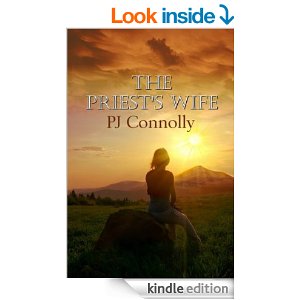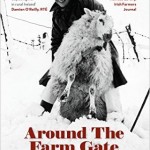The Priest’s Wife to me sounded as though it was going to be about a torturous relationship between a priest and either his mistress or a woman that loved him fiercely but he loved God and Rome more. Set mostly in the 1970s, the opening chapter reveals a young nun having to lick spilled salt and pepper off the dusty floor on her 21st birthday as the Mother Superior seems intent on humiliating her as much as possible.
 Brought up CoI, I had very little experience of nuns beyond meeting the occasional one in their habit around Carlow. My nana, who babysitted me, used to say how cruel they were, how they beat education into the children which always seemed to me to be such an oxymoron. Surely religous people who were doing God’s will would be kind and generous to everyone? We now know from the thousands of examples that many of Ireland’s religious seemed intent on being as cruel as they possibly could.
Brought up CoI, I had very little experience of nuns beyond meeting the occasional one in their habit around Carlow. My nana, who babysitted me, used to say how cruel they were, how they beat education into the children which always seemed to me to be such an oxymoron. Surely religous people who were doing God’s will would be kind and generous to everyone? We now know from the thousands of examples that many of Ireland’s religious seemed intent on being as cruel as they possibly could.
Yet, this book was set in the 1970s. It’s not that long ago after all. Yet, in Modern Ireland which has changed so much in the last 20 years, the 1970s might as well be a century ago. ?Sister Susan isn’t an orphan. She has a family, a father and sister who would prefer to see her out and about. She is attending university. Why did she choose this particular convent where she has to wear a heavy habit rather than secular clothes to university (as a friend does)? Why does she put up with the humiliation and the cruelty when she has other choices? Is it simply out of loyalty to her deceased mother? ?Is she going to endure that humiliation forever?
As you can see, the book raises many questions and that’s just in the opening chapters. Add to that the topics of adultery, polygamy, illegitimacy, abortion, suicide and we are dealing with many subjects which were and still are taboo in Irish society. There’s the typical Irish way of life too – trying to keep things secret from nosy neighbours, travelling into the city for work, the power of the Church and the Medics.
Told through Susan’s point of view, we share her frustrations and understand her reasons for the ‘menage a trois’ in her later life. We may feel that we never really understand what makes Finbar tick but then Susan admits that too. Part of that makes me want to shake her and get her to slap him and part of it I accepted as probably normal life too. Both seem to immerse themselves in work following the death of their baby and the knowledge that they won’t have more children seems to drive them apart to an extent.
This is a well written historical novel, shedding light on Irish life that isn’t so long ago but yet seems so different. So much of life in Church institutions has been written and it is interesting to see how two people live secular lives having spent time in the Church. ?It asks many questions too – for example, isn’t it about time that priests and nuns marry if they wish to do so? Surely much of that cruelty from previous decades would have been prevented – how much of it was due to men and women shutting down their emotional side in the absence of love and children I wonder? I’m not referring to sexual abuse here but to the emotional abuse experienced by many in their care and under their teaching.
I was delighted when PJ agreed to an online interview and I found his answers to be fascinating. It’s good to see an insight into an author’s reasoning and inspiration. I hope you enjoy the read.
1. Where did you get your inspiration from? It suggests that you have had some experience of working within the Church or certainly with a theology background. Do you?
Well spotted, Lorna!? Yes, you?re right. I spent a total of eight years preparing for the priesthood but didn?t go through with it in the end. Those years gave me a unique insight into the state of the church in the sixties and seventies. It was the time of Vatican Two and there was a great sense of expectation about reform and liberalisation in the Catholic Church. I make use of this theme in the novel where Finbarr?s efforts to get a dispensation run into a stone wall with the arrival of the new Pope John Paul the Second.
I?m personally acquainted with a number of ex-priests who have married in civil ceremonies because they were refused a dispensation by the Vatican. In fact there are many thousands in that position around the globe.
2.?The beginning was very stark and really emphasised the cruelty of many in power in the Church. It surprised me that a young woman, in the 1970s, would stay in the Church after that, given that she was educated and had family support. Do you think the control of the Church was that strong that they thought they could maintain it? I thought it was interesting that Sr Consolata also left the church. Do you feel you could have written about the Church in this way back in 1980 or is that only possible now due to recent coverage re what often went on?
For the young Sister Susan life in the convent is a mighty struggle as she feels herself being dragged in different directions.? Deliberate humiliation was par for the course in the religious formation of a young nun. If she couldn?t take it she was advised to forget about the religious life. I know all about it. As a young cleric I had to undergo this so called novitiate year to teach me humility and obedience. I?ve no reason to believe this aspect of religious life has changed much. It?s just that it?s kept very much under wraps.
If I?d written this back in the seventies I might have been accused of gross misrepresentation. Now readers are more open to what might be going on behind closed doors.
3.?We read the novel from Susan’s point of view which reveals much about her thoughts but means that the other main characters remain slightly in the shadows – why did you decide on that for narration?
It?s simple really. I chose to make it a memoir. A fictional memoir. It?s one person?s story and told purely from that person?s point of view. So we only see the other characters through Susan?s eyes. She is gifted enough and educated enough to be able to present a pretty perceptive account of their strengths and weaknesses as well as of her own. Several times she admits that she never really got to know her husband or what it was that made him tick.
4.?I thought it was interesting the way you brought in many historical events, one being the hysterectomies performed by a Dublin doctor. This, of course, we discover later was crucial to the plot. Do you see this as being a historical novel?
Yes, I see this as a historical novel. Life since the seventies and eighties has changed beyond? recognition. Any of you who have grown up in the intervening years must find it quite impossible to believe how things were then, especially the craven submission to authority where people believed what they were told to believe, did what they were told to do and didn?t dare question those in positions of power.
It?s in that context that The Priest?s Wife must be read.
5.?The choice of title was interesting and I assumed that Susan would end up being a priest’s mistress. What other connotations have people read into it?
Some people who have read my novel have suggested it should have been called The Priest?s Wives!? And I had to agree it might have been a more apt title.
6.?Polygamy was an interesting introduction to the latter part the book, as were the Biblical references to it. ?Do you think this will shock readers?
That was my big fear when I launched the book in November, that some people would be shocked to the core. The idea of one man, two wives would be a step too far in holy Ireland. I could see myself being ostracised by my more conservative friends.? But my fears were unfounded.? So far nobody has blinked an eyelid! Not a single reader. None that I know of at any rate.? It?s true Susan makes some difficult choices but it?s clear her motivation is of the purest and I think that?s why she retains the reader?s sympathy and respect.
If you would like to order the printed version, you can get it direct from the publisher?s website, Wings eBooks. It is available as an ebook?from Amazon Kindle.Do check out Paddy’s blog too – his latest post is an interesting one on polygamy.







